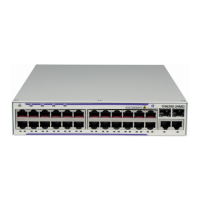Interface Configuration
7210 SAS M, T, X, R6, R12, Mxp Interface Configuration Guide Page 65
1. VPLS service, SAP to SAP, SDP to SAP (that is, egressing on a SAP): For Unlearnt
traffic, load-balancing does not happen (for both L2 and L3).Traffic always egresses on
Flood-port (shown in “show lag <lag-id> detail”).
2. VPLS service, SDP to SDP: Test has been performed only for VC label variation with
the same Tunnel label.
3. ‘Learnt’ wherever mentioned corresponds to Destination MAC.
4. Source/Destination MAC refer to ‘Customer Source/Destination MACs’ unless otherwise
specified.
5. In case of a lag with 2 ports at the egress, different Ingress port-Ids may result in the
same hash-index, resulting in traffic always getting hashed to only one of the ports. With
more than 2 ports in the lag, load- balancing is expected to take place.
IES (6PE) (IPv6 traffic)
SAP to SDP
Source, Destination IP address, Source,
Destination port (L4), Ingress portId
IES (6PE) (IPv6 traffic)
Network Port to SDP
Source, Destination IP address, Source,
Destination port (L4), Ingress portId
IES (6PE) (IPv6 traffic)
SDP to SAP
Source, Destination IP address, Source,
Destination port (L4).
IES (Multicast IP traffic)
IP interface (Network or SAP) to IP
interface (SAP)
IPv4 Multicast traffic: Software picks a port
Network Port IP interface (Multicast
IP traffic)
IP interface (Network or SAP) to IP
interface (Network)
IPv4 Multicast traffic: Source and
Destination IP, Source and Destination L4
ports, Ingress Port-Id.
Table 11: LAG Hashing mechanism for services configured on 7210 SAS-R6 and 7210 SAS-R12 devices
Services and Traffic Direction Packet fields used for Hashing for differ-
ent traffic types

